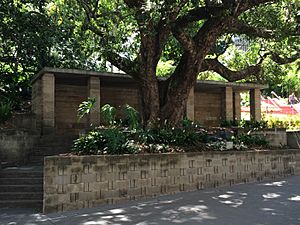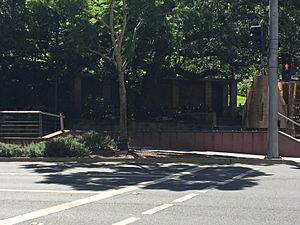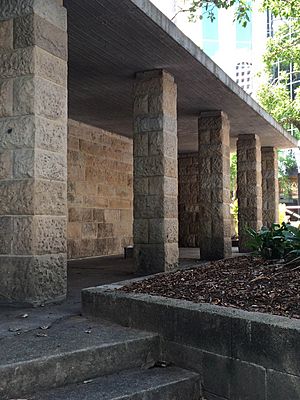King Edward Park Air Raid Shelter facts for kids
Quick facts for kids King Edward Park Air Raid Shelter |
|
|---|---|

King Edward Park air raid shelter, 2015
|
|
| Location | 224 Turbot Street, Brisbane City, City of Brisbane, Queensland, Australia |
| Design period | 1939 - 1945 (World War II) |
| Built | c. 1942 |
| Architect | Frank Gibson Costello |
| Official name: King Edward Park Air Raid Shelter | |
| Type | state heritage (built) |
| Designated | 6 April 2005 |
| Reference no. | 602475 |
| Significant period | 1942 (fabric) 1940s (historical) |
| Builders | Brisbane City Council |
| Lua error in Module:Location_map at line 420: attempt to index field 'wikibase' (a nil value). | |
The King Edward Park Air Raid Shelter is a special old building in Brisbane City, Queensland, Australia. It was built around 1942 during World War II to keep people safe from air raids. Today, it's a heritage-listed site, meaning it's an important part of Queensland's history.
Protecting Brisbane: Air Raid Shelters
The Brisbane City Council built this stone shelter in King Edward Park in 1942. This was a time when Australia was preparing for possible attacks during World War II.
Why Shelters Were Needed
On December 7, 1941, the United States joined World War II after Japan attacked Pearl Harbor in Hawaii. The war became truly global. Japanese forces bombed Darwin in February 1942. Many Australians were captured when Singapore fell.
Australia quickly made plans to defend itself from a possible Japanese invasion. Queensland became an important support base for the war in the Pacific. Many Australian and American soldiers came to Queensland. Brisbane's population grew a lot.
Brisbane's Role in World War II
Brisbane was the biggest city in Queensland and the most northern major city in Australia. Because of this, it became a key military planning center. Important maintenance, communication, and supply facilities were set up here.
General Douglas MacArthur, who led the Allied Forces in the Southwest Pacific, was based in Brisbane. General Sir Thomas Blamey, who led the Australian Forces, also used buildings in Brisbane. Since Brisbane was a major target, quick action was needed to protect people from air raids.
Building Shelters in Brisbane
Building new structures during the war was hard because materials and workers were scarce. Military projects got first pick of everything. Large anti-aircraft guns were placed around Brisbane. Coastal guns were set up on Bribie and Moreton Islands.
The Brisbane City Council was in charge of Air Raid Precautions. This included setting up air raid wardens and firefighting systems. They also built air raid shelters. Saltwater pipes were laid in city streets for firefighting.
Orders to Build Shelters
In December 1941, the Queensland Premier ordered the Brisbane City Council to build 200 public shelters in the city. Work started quickly, and later, 75 more shelters were ordered. In the end, 235 air raid shelters were built. Most were finished by June 1942.
The council also built about three kilometers of covered trenches in public parks. These trenches could hold many people. Shelters were also built for important places like wharves and for workers under the Story Bridge.
Shelters Across Queensland
Other towns along Queensland's coast were also ordered to build shelters. These shelters had to follow strict rules to protect people from bombs. Some towns found it hard to build enough shelters. The government sometimes had to step in to help.
Smart Design for the Future
Of the 235 public shelters built in Brisbane, only 21 are still standing today. Most of the war structures were removed after World War II. However, some shelters were designed to be reused.
Frank Gibson Costello's Vision
Frank Gibson Costello was the Brisbane City Architect from 1941 to 1952. He designed the surface air raid shelters. He wanted them to have a purpose after the war, not just be useless concrete blocks.
Costello used a modern architectural style. This style focused on using new materials and practical designs. He wanted the shelters to fit into city improvement plans after the war. Many of these reusable shelters were placed under fig trees to help hide them.
Different Shelter Designs
Costello designed a few types of reusable shelters:
- "Park" type shelters: These had four central pillars supporting the roof. Their outer walls could be removed after the war. This would turn them into open park shelters. Seventeen of these "park" type shelters still exist today. Most are used as simple park shelters.
- "Bus" type shelters: These were designed so that three brick walls could be removed. This would leave a concrete back wall and five brick pillars. Only two of these "bus" type shelters remain.
- "Bus (stone)" type shelters: This was similar to the "bus" type but used a stone back wall and six stone pillars. The King Edward Park shelter is the only one of this type that still exists.
Many of the shelters that were designed to be reused are still here today. This shows how clever Costello's designs were. They were given a new life after the war.
The King Edward Park shelter had its front wall removed after World War II, just as planned. Six stone pillars were added. You can still see where the original wall was. The roof was replaced in 1995 to look like the original.
What It Looks Like Now
The King Edward Park air raid shelter is a rectangular building made of stone and concrete. It has a heavy floor, stone walls on the back and sides, and six stone pillars at the front. It has a flat concrete roof.
You can reach the shelter by two sets of concrete stairs from Turbot Street. All the stone parts have a rough, hammered finish. The concrete roof is newer, but it looks like the original.
Why It's a Heritage Site
The King Edward Park Air Raid Shelter was added to the Queensland Heritage Register on April 6, 2005. This means it's officially recognized as an important historical place.
Showing Queensland's History
This shelter is important because it shows how Brisbane prepared for defense during World War II. It reminds us how the war affected everyday people in Brisbane. It was built to protect civilians from air raids.
A Rare Survivor
Many air raid shelters were built during World War II in Queensland, but very few are still standing. This shelter is one of the few wartime structures built by the Brisbane City Council that still exists.
A Great Example of Its Kind
The shelter's strong build, rectangular shape, and location near a busy area show what a typical public air raid shelter in Brisbane looked like during World War II.
Clever Design and Technology
The King Edward Park air raid shelter is now used as a shade shelter. This shows how its original design allowed for new uses after the war. It's a lasting example of smart design and the use of concrete during World War II.
Connected to Important People
This air raid shelter is also important because it's an example of the work done by the City Architect's Office during the war. It especially highlights the designs of City Architect Frank Gibson Costello.



